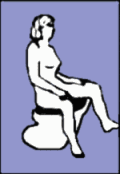|
The Treatment of Sexual Dysfunctions - Sex Therapy
|
|
The “Classic” Dysfunctions - The Treatment of Female Sexual Dysfunctions
|
|
Absence of Orgasm - Treatment
|
|
 Identifying the PC Muscle Identifying the PC Muscle
Half a century ago, the American gynecologist Arnold H. Kegel developed some exercises for this particular muscle which can be practiced by any woman at any time anywhere. Naturally, first she must learn how to identify the muscle for herself. In order to do this, she is advised to sit on the toilet with her legs spread as far apart as possible. If she then starts and stops the flow of urine, she becomes aware of the pubococcygeus because it is the only muscle that can stop urine under this circumstance. However, if the muscle has atrophied and become weak, the woman may not be able to identify it this way. In this case, it may also prove difficult or impossible to locate the muscle by inserting a finger into the vagina. The condition can be improved by special exercises described in the next section.
|
|
|
|
Feeling the Pubococcygeus (PC muscle).
Normal PC muscle tone: When the top half of the index finger is inserted into the vagina and then moved about, it feels resistance in all directions. The woman can voluntarily contract the muscle. (left)
Weak of absent PC muscle tone: The middle third of the vagina is roomy, and the vaginal walls feel as if they were detached from their surroundings. The woman cannot voluntarily contract the muscle. (right)
Schematic drawings after Kegel's own illustrations.
|

